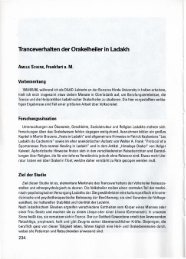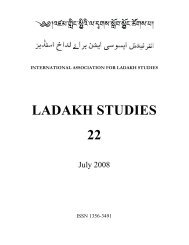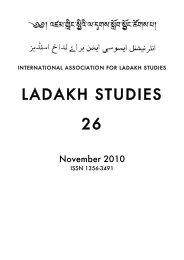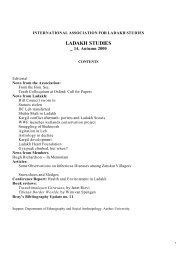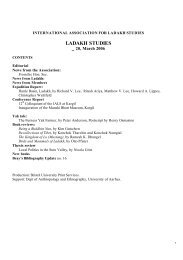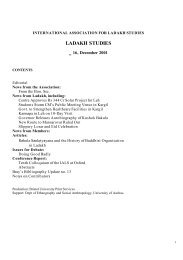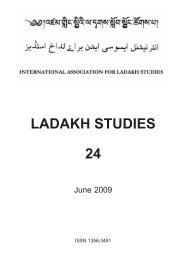LADAKH STUDIES 12, Autumn 1999 - International Association for ...
LADAKH STUDIES 12, Autumn 1999 - International Association for ...
LADAKH STUDIES 12, Autumn 1999 - International Association for ...
You also want an ePaper? Increase the reach of your titles
YUMPU automatically turns print PDFs into web optimized ePapers that Google loves.
With few exceptions the only non-Shias in Leh township who knew of Asad were those select<br />
Sunni Muslims—a handful of preachers and scholars—who are given written invitations every year<br />
by the village organizing committees and are asked to offer a guest sermon. Interfaith gestures are<br />
much more characteristic of Ladakh’s urban celebration of Muharram. In Leh township members<br />
of the Ladakh Buddhist <strong>Association</strong> are invited to attend the “funeral feast” in honor of Husain on<br />
the fourteenth of Muharram; and the Sunni Anjuman-e Mu’in-e Islam turns out in strength to join the<br />
Shia Zuljenah procession and shout Allahu akbar along the length of Leh’s main bazaar. Sunnis do<br />
not march in the villages’ Lion processions, I was told. They confine their show of pan-Islamic<br />
solidarity to downtown Leh, on Ashura, where they feel they will make the greatest impression. All<br />
of this suggests the provincial flavor of the Day of the Lion.<br />
Earlier I mentioned the flexible quality of scheduling with regard to Yawm-e Asad. An example<br />
of this occurred in the summer of <strong>1999</strong>, when I first witnessed the Day of the Lion. My <strong>1999</strong> visit<br />
coincided with the Kargil Crisis, when Pakistani soldiers and Pakistan-supported mujahideen crossed<br />
the Line of Control and threatened parts of western Ladakh and Kashmir. When I arrived in Leh in<br />
July I was in<strong>for</strong>med by Shaikh Muhammad Ali Zubdavi, chief maulvi of Thikse, that the season’s<br />
first Asad observance would be held on Sunday, August first. But then Chushot Yogma’s planning<br />
committee postponed the event until the following weekend, August 8. The reason: a number of<br />
village Shias, I was told, were still away in the Kargil district, serving the army as porters in the war<br />
zone. The postponement allowed some of them to return home in time <strong>for</strong> Asad.<br />
Worth noting here is one other datum concerning the geographic distribution of Asad<br />
observances. Seyyed Naqi Shah of Chushot in<strong>for</strong>med me that the Day of the Lion is also held in<br />
parts of Kashmir, especially in Zadibal, a Shia neighborhood in Srinagar. As in Ladakh, Srinagar’s<br />
Asad observances include a majlis and a Zuljenah procession. I expressed surprise at the latter,<br />
knowing that Muharram processions have been banned in Srinagar <strong>for</strong> years, due to proindependence<br />
violence by militants. “Yes,” acknowledged Naqi Shah, “the Muharram Zuljenah<br />
jalus has been banned, because that always used to involve lakhs of people [hundreds of thousands].<br />
But the Asad procession is smaller-scale and confined to a given locality.” 9<br />
3. Recent interpretations of Khamenei’s fatwa in Ladakh<br />
I interviewed a number of Kargili Shias resident in Leh and learned that the Day of the Lion is also<br />
observed in Kargil district, but with the same town-country distinction found in Leh. That is,<br />
Muharram is observed in Kargil township, while Asad is celebrated in the villages.<br />
9 8 See also the newspaper article concerning Asad observances in Srinagar entitled “Religious<br />
Congregation Observed,” Daily Excelsior (Jammu), August 7, <strong>1999</strong>.<br />
26




